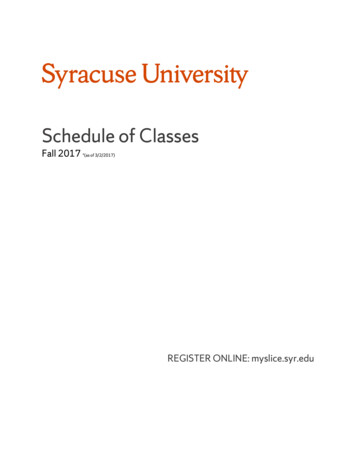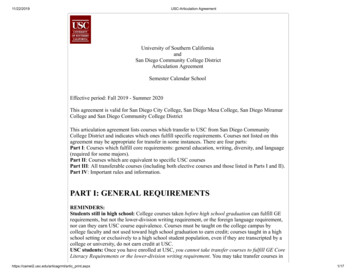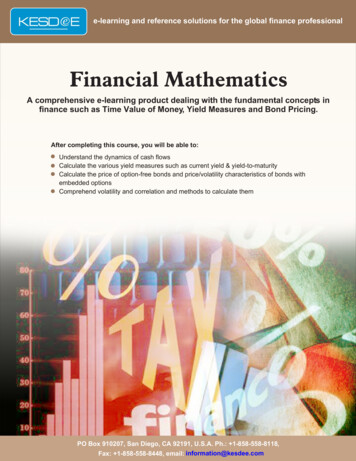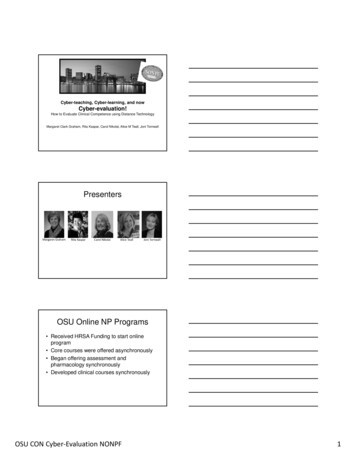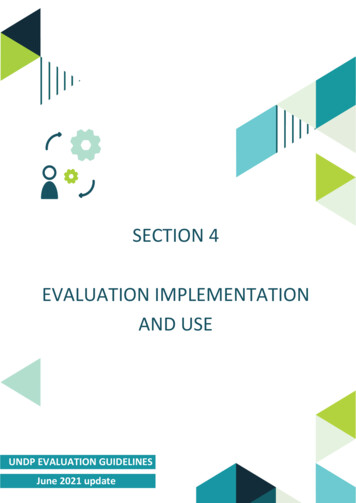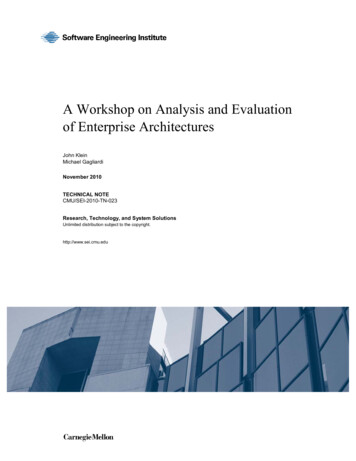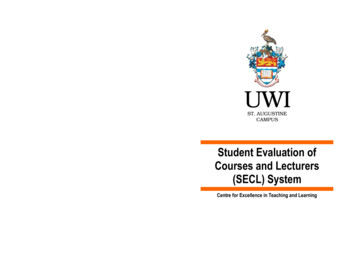
Transcription
Student Evaluation ofCourses and Lecturers(SECL) SystemCentre for Excellence in Teaching and Learning
AcknowledgementsResearch Team: Contract Officer II Ms. Kimila Inniss, Research Technician, Mr.Marc Garcia.2For specific requests and information regarding the SECLsystem, please contact:Ms. Kim Inniss or Mr. Marc GarciaCentre for Excellence in Teaching and LearningTeaching and Learning ComplexUWI, St. AugustineTel: (868) 662-2002 ext. 82611Email: seclreports@sta.uwi.edu31
Appendix 5 (a) & (b)Table of ContentsForeword by the Campus Principal4Foreword by the Deputy Principal5Introduction6Use of SECL Reports6The SECL Process8SECL Online systemAdministrative Responsibilities of the DepartmentCriteria for Using the Online SECLAdvantages of the Online SECL ProcessChallenges of the Online SECL ProcessNavigating through the Online SECL softwareAccessing ReportsOnline SECL Time-line schedule for Department AdministratorsCETL ResponsibilitiesSummary Checklist & Guide for each Online SECL user-Lecturers-Administrators-Student Liaisons-Heads of Departments-StudentsReportsTips for Increasing Response rates for Departments1919FAQs20Appendices:Photos of Prize Giving Ceremony for Students and Departments(School of Veterinary Medicine) in Semester 1 & 2 2016/17308910111112151616171717171818Appendix 1: Course Evaluation QuestionnaireAppendix 2: Example of Online SECL ReportAppendix 3: Example of Online SECL FlyerAppendix 4: Example of PowerPoint PresentationAppendix 5: Photo of Prize Giving Ceremony for Departmentsand Students3
Foreword by the Campus PrincipalAppendix 4Teaching and learning is central to the strategic mission of the St. AugustineCampus of the University of The West Indies and is a distinguishing feature ofour regional University. The new Student Evaluation of Courses and Lecturers(SECL) System is therefore a welcome initiative, as feedback from students toour lecturers on the course content, delivery effectiveness and learning experiences is essential in the process of quality enhancement in our classrooms.Responsiveness, consistency and timeliness of reporting and feedback are keyindicators that will take our University and Campus forward.I would therefore like to take this opportunity to encourage all staff and studentsto support this important process, in keeping with our Campus’ commitment toquality and excellence, particularly in the area of teaching and learning. I wouldalso like to commend the Director and staff of the Centre for Excellence inTeaching and Learning (CETL) for their dedicated efforts at ensuring that theUWI, St. Augustine Campus continues to not only meet quality assurancestandards, but to surpass them through a process of continuous improvementof our teaching and learning.Student Evaluation of Course and LecturerDear Student,The evaluation process has started. We would appreciate your feedback on yourlecturer and course. Please take a moment now to login to your UWI email account,find the evaluation email, then copy and paste your username and password into therequired fields and then click sign in and proceed to complete your evaluations. Eachevaluation should take 10-15 minutes to complete.Thank you for your co-operation.Professor Clement SankatPro Vice Chancellor and Campus PrincipalUWI-CETL TeamExample of PowerPoint Presentation429
Appendix 3 (b) & (c)Foreword by the Deputy PrincipalThis booklet is a welcome tool in the arsenal of support mechanisms necessaryfor the improvement of teaching and learning at The University of the WestIndies, St. Augustine Campus. It is of absolute importance as a guide to theprocess of evaluation of faculty by students, which is analysed and the resultsdisseminated by the Centre for Excellence in Teaching and Learning.The location of this process of analysis of student evaluation of faculty withinthe Centre for Excellence in Teaching and Learning highlights the value that theUniversity places on teaching and learning. It also underscores its desire toensure that members of faculty take every opportunity to improve their pedagogical techniques and that they do so taking into account the opinions, perceptions and experiences of the students that they teach.Best practices among progressive tertiary educational institutions indicate thatthe narrow focus on publication for promotion and tenure is giving way to anexpanded space for the inclusion of teaching as an important criterion of assessment for advancement. Student evaluation reports provide the foundationfor further movement in this direction by the University of the West Indies, St.Augustine Campus. The importance of this booklet as a guide for faculty onhow to use the reports to develop their skills and personal attributes for effective teaching cannot be overstated.It is also an important companion document; a must read for all administratorsinvolved in the implementation of student evaluations to ensure the integrity ofthe process.I would like to thank the Director and staff of the CETL for its commitment toquality by ensuring that attention to procedure and by extension to quality ofoutput is addressed through publications such as these.Professor Rhoda ReddockDeputy PrincipalExample of Online SECL Flyer285
Appendix 3 (a)Student Evaluation of Courses and Lecturers (SECL) SystemIntroductionThis booklet provides information and guidelines to all staff members of TheUWI, St. Augustine about the Student Evaluation of Courses and Lecturers(SECL) system, which commenced in the 2010-2011 academic year. The evaluation process is implemented by the Centre for Excellence in Teaching andLearning (CETL) and is scheduled for each semester.The purpose of the SECL system is to provide feedback to Lecturers and otherrelevant staff members on students’ classroom and/or learning experiences andlearning opportunities as can be garnered from their perceptions. Each Lecturer is individually evaluated and feedback reports are provided on the students’course experiences to him/her as well as the Head of Department (HOD) andthe Dean of the Faculty.The SECL system is a strategic tool for Lecturers who should use the feedbackinformation to improve students’ learning opportunities and address studentmatters in their teaching that impact student learning. It is anticipated thatHODs, and in some cases, Deans will provide Lecturers with the requisite assistance and guidance to improve students’ learning experiences.Use of the SECL ReportsThe SECL reports can be most effectively used for developmental purposesprimarily aimed at helping Lecturers develop their teaching skills and personalattributes which impact teaching effectiveness. These include communicationefficacy, student engagement, and creation of facilitating learning environments. Table 1 summarises actions that may be taken on receipt of the SECLreports, and indicates the attendant value and/or importance of taking theseactions.Following these suggestions will not only impact the quality of student learningexperiences at the institution, but will also address steps in the quality assurance process that distinguishes The UWI as a higher education institution ofbest practice in teaching and learning.Example of Online SECL Flyer627
Appendix 2(a)Table 1. Possible Ways of Using the Feedback Provided in the SECL SystemPossible ActionsImportance1. Lecturers note perceptions and concerns of Provides feedback on the students’ classtheir students.experiences. While students may take theopportunity to report negatively on lecturers,Ramsden (2003) and other higher educationresearchers show that most of the time students use the opportunity to provide an accurate picture of their experiences. Lecturersmust take into consideration what the majorityof students perceive.2. Lecturers and Heads/Course Coordinators This helps in identifying and articulating thehold discussions relevant to student concerns.experiences and/or problems that impactedstudents’ perceptions. There is opportunity todistinguish problems outside the purview of thelecturer from those under his/her control. Corrective steps can be taken in either event.3. Lecturers (with guidance, if necessary from Often all problems cannot be addressed atHODs/Course Coordinators) set new and realis- once so setting goals will allow a system fortic goals for students and themselvesprioritizing. In addition, this underscores thedeliberate and systematic enterprise that isteaching. However, setting teaching goals is askill and the input of the Heads of Departmentswill be critical in this regard.4. Lecturers and HODs/Course Coordinators Opportunity to determine when lack of approidentify teaching skills gaps.priate teaching skills is indicated e.g. how toteach large classes.5. HODs/Lecturers make arrangements for Once the problems have been identified therelevant training.HOD can arrange for or recommend appropriate training either individually or as a department. Lecturers can attend workshops orconsult with the CETL or other relevant entityfor assistance.6. Lecturers subsequently modify/adjust select- The SECL system allows for changes in teached teaching strategies/ways of engaging stu- ing the courses subsequently, e.g. the followingdents.semester. (Lecturers also need to obtainfeedback during the course to make adjustmentto their teaching – this often requires sometraining).7. Compare subsequent student perceptions This provides the lecturers with feedback onand performances.whether teaching and assessment strategiesmodified/employed worked, i.e. closes thefeedback loop.Example of Online SECL Report267
The SECL ProcessAppendix 2(b)The SECL process is initiated by the electronic submission of questionnaires tostudents for each course, which they complete to indicate their perceptionsabout their course experience and view of their course lecturer. The SECL process usually commences in the third week of the semester and engages theCETL staff well into the following semester. It involves obtaining lists of allcourses being offered by each Department/Faculty, assigned Lecturers, numbers of students in each course and other relevant data. This information isobtained from the Departments and is considered extremely important. If aDepartment supplies incorrect information, then this will reflect in theLecturers reports and the courses they teach.SECL Online SystemThe SECL system online version utilizing software called CoursEval has fullyreplaced the traditional paper-based version in Academic Year 2016/17. Theprocess is outlined on page 9. All criteria for the online process must also bemet as outlined on page 10. All Deans, HODs, Teaching staff, Departmentadministrators and registered students have an account where they can loginand access their respective content each semester.The CETL does the processing of all questionnaires and submits reports to therelevant Lecturer, his/her HOD and the Dean through the software, as agreedat the meeting of Extended Campus Management Committee held on 11 th,September, 2011.The steps involved in this process are itemised in the context of the semestertimeline in the section titled SECL Process Timeline on page 16.Details of the SECL online process is outlined hereunder.Example of Online SECL Report825
Appendix 2(a)Administrative Responsibilities of the DepartmentAs with the paper-based SECL process, each Department is responsible forinitially providing accurate departmental information early in the reporting cycle.The information required for EACH course is as follows.(1) Course Code(2) Course Title(3) Full Name of Lecturer (s)(4) No. of Students Enrolled Per Course(5) Head of Department(6) DeanThe information must be sent via email to the Research Team at the CETL atseclreports@sta.uwi.edu by the 3rd or 4th week of the relevant semester.After this information is supplied, together with corresponding student listingsobtained from Campus Information Technology Services (CITS), it is then exported to the CoursEval database software where individual accounts are created and updated for all users each semester. Users include all Teaching staff,Students, Principal, Deputy Principal, Deans, HODs and Department Administrators involved in the SECL process.There are two components to the SECL questionnaire– a quantitative component the responses to which is based on a Likert scale, and a qualitative component which provides open-ended responses to the questions. Therefore, twotypes of reports are generated from the SECL process, one that relates to thequantitative section of the form and the other relevant to the qualitative section.The reports are as follows:Example of Online SECL Report249
Appendix 1 (b)(1) Quantitative – Analysis of the rating scale questions in Section 1. Thissection utilizes the following Likert scale:1 Strongly Disagree2 Disagree3 Neutral4 Agree5 Strongly Agree6 Not applicable(2) Qualitative – The students’ responses to the open-ended component ofthe questionnaire are sent in total to the Lecturer, HOD and Dean. Thisvery valuable component of student feedback provides deep insight intostudents’ course experiences and should be treated as the invaluable toolthat it is. Consideration of students’ comments should underpin the discourse among Lecturer, HOD, and Dean.A Condensed Analysis report is generated as a PDF file (Adobe Reader format). This report is accessed by the relevant Lecturer, HOD and Dean via theCoursEval software portal.All courses and departments must aim to achieve a 35% overall responserate. In order to achieve to the foregoing Departments must meet the followingcriteria.Criteria for Using the Online SECL1) Each Department must delegate an Administrator (AA) who will commit tothe process or another staff member for example a Secretary or Clerical Assistant who can work in their absence and provide an accurate listing as stated onpage 92) A student liaison/representative must be assigned for each course or yeargroup. He/she must communicate with the Department Administrator regularlyregarding the start and end time of the process as well as the response ratesfor each course. In turn, the liaison must update the students accordingly andencourage them to complete the online SECL before the end date whilst monitoring the response rates3) The AA or student liaison must go to each class 10/15 minutes before orafter and ask students to: login in to their UWI email account, search for theOnline SECL notification email (follow instructions contained in the email) andcomplete the online SECL for their respective course (s). Lecturers must beconsulted on a suitable day/time to execute this.10Back page of student COURSE evaluation form for general purposes.23
Appendix 1 (a)4)Each Department must be responsible for updating all lecturers on all SECLactivity this includes, the method, start and end date of the SECL process foreach Semester and lastly the response rates for each course. If a responserate is low for a course the Administrator must notify both the lecturer and student liaison accordingly5) Although CETL sends reminders to the students to complete the onlineSECL, it is also the responsibility of the Department to ask Lecturers and student liaisons to remind the students to check their email addresses and complete the online questionnaire. All Lecturers must be supportive of the onlineSECL process5) All Lecturers must embed a message into myeLearning asking students tocheck their UWI email account and complete the online questionnaire. togetherwith flyers in Appendix 3.6) The AA must add flyers provided by CETL (this serves as reminders for students to check their UWI email addresses) to the Department’s notice boardwhen requested.Advantages of the Online SECL processThe first benefit of using the online system is the faster completion of the reports. The online SECL reports are available two weeks after examinationresults have been released, whereas the hard copy SECL reports are completed within six months. This gives teaching staff a chance to make relevantchanges to their course design and delivery for the next Semester. Anothermajor benefit of the online SECL process is that all HODs and teaching staff willhave an account where all reports are stored and can be accessed at anytime.This will allow particularly HODs to examine perceptions of students’ experiences across the Department in addition to their perceptions about individualcourses.Challenges of the Online SECL processAchieving a high response rate is a major challenge for the Online SECL. Boththe Department and CETL must work together to find ways to motivate andencourage students’ to check their UWI email accounts and complete theonline SECL questionnaire. Recommendations on how to increase responserates is outlined on page 19.Front page of student COURSE evaluation form for general purposes.2211
Navigating through the Online SECL SoftwareThe online SECL process occurs once each Semester (twice a year). Whenthe survey becomes live it will remain active for three to four weeks. Withinthat period a series of activities occur. These activities are illustrated next.Firstly, before the survey becomes live all Lecturers will receive two emails.One email (See Figure 1) contains individual login details such as usernameand password. It is recommended that all account holders change their password upon first login.Figure 1 Login Screenview SampleAppendicesThe second email contains course details with student listings (See Figure 2).Upon receipt of emails all Lecturers must verify the information provided andcontact the CETL Research team atseclreports @sta.uwi.edu should any problems arise.Figure 2 Course Details Screenview Sample1221
FAQSWhich staff members are evaluated?Full time and part time lecturers only.Next, click on the link circled in Figure 3 to access the site, this will open theCoursEval portal.Figure 3 Highlighted Login details Screenview SampleCan a guest lecturer be evaluated?No, a guest lecturer should not be evaluated.If there is more than one lecturer per course or module, should they be individually or collectively evaluated?Each lecturer should be individually evaluatedper course or module.Are Theses supervisors and Projects evaluated?No, they are not only courses.I am new to this process how do I access my CoursEvalaccount if I have one?Please contact any member of the CETL ResearchTeam Ms. Kim Inniss or Mr. Marc Garcia viaseclreports@sta.uwi.edu and your login detailswill be sent to you via email.20Then, copy and paste your username and password contained in Figure 1&3and place into the required fields in Figure 4 and click sign in.Figure 4 CoursEval Portal where username and password will be copied andpasted Screenview Sample13
After logging in, all teaching staff will be able to view a list of each coursetaught and their corresponding response rates (when the survey is active).Figure 5 CoursEval Portal course details and response rates ScreenviewReportsAll online SECL reports are completed and accessible two weeks after examination results have been released. All departments must provide the relevantinformation listed below in week 3, so that the students’ are able to completethe questionnaire before classes end for the semester.Tips for increasing response rates for DepartmentsBoth Administrators and HODs will be able to access response rates for allcourses within their department (See Figure 6) whereas Lecturers will only beable to view response rates for their course (s) only (See Figure 5).Figure 6 CoursEval Portal Administrator and HOD ScreenviewFor a video illustration on Navigating through the CoursEval software pleaserefer to the following guide for logging in and viewing response rates https://www.youtube.com/watch?v qqv2UYIHCC0 and accessing reports https://www.youtube.com/watch?v -KVt6n3IurQ .14In addition to managing the SECL online process, the CETL research teamalso work together with Marketing and Communication to promote the processnamely through advertising on social media platforms such as Facebook andTwitter; via email on What’s On; creating flyers and videos (for all users). However, assistance from AAs, Lecturers, student liaisons are also needed to disseminate information and to further promote the process. Each course shouldaim to achieve a response rate of 35%. As mentioned previously obtainingthis rate can be challenging and below are a few recommendations on how thiscan be achieved. Students tend to be more motivated to complete their evaluations oncetheir voice is being heard and acted upon, therefore Lecturers must communicate the value of course evaluations with their students. Thus, it isimportant to highlight changes made to the course based on previousfeedback and how useful it is for improving course design and delivery,this way students would know the impact of completing their online SECLand accept the process. Student liaisons must also communicate withtheir class-mates with regards to the start time, end time of the onlineSECL process and encourage them to complete their evaluations. Schedule 10-15 minutes before or after class for students to complete theevaluation using their phone, tablet, laptop or PC. Wi-Fi is needed. A student liaison/representative or AA should direct this exercise The Lecturer via the Department can reward students for completing theirevaluations, this can be done by: giving tips for an upcoming exam if theresponse rates increase by a certain percentage etc. or to give an additional review session Promote course evaluations through; myelearning placing a slide or PowerPoint illustration (Appendix 4); playing a one minute video https://www.youtube.com/watch?v i550MQE7b0s or https://www.youtube.com/watch?v 1qgxeFfWiqs during class time Prizes are awarded to one student per faculty (once they have completedall their evaluations) as well as to departments with the highest responserates.19
Heads of DepartmentsAccessing Reports All Lecturers will be able to view their individual reports for each course evaluated . Each HOD will have access to each Lecturer’s report within their department and lastly each Dean’s will be able to access each lecturer’s report for alldepartments within their faculty. All reports (in PDF format) will become available two weeks after examination results have been released. Each HOD mustsave the reports electronically and in a central area such as the y: drive,so that future HODs would be able to access. Please note that DepartmentAdministrators would not have access to reports due to confidentiality. Ensure that the designated SECL Administrator has the correct emailaddress for all Lecturers on fileEnsure that each Lecturer liaise with the AA or student liaison to schedule10 –15 minutes a week for each class to complete the online evaluationView instructional video on how to Navigate through the CoursEval software https://www.youtube.com/watch?v qqv2UYIHCC0 and https://www.youtube.com/watch?v -KVt6n3IurQCheck your email, login to your account and change your passwordEnsure that all lecturers have verified the information listed such as coursenames, course codes and students’ enrolment are correctEnsure that AAs have placed the advertisement provided by CETL on thenotice board and/or added to department social media account (if any)While the survey is live ensure that Lecturers show PowerPoint slide/Flyerand they schedule time for the AA or student liaison to conduct the exercise within each Semester. Lecturers must alert students during classeach week and encourage them to complete the survey explaining theusefulness of feedbackSurvey reports for each Lecturer and course will be available 2 weeks afterexamination resultsSurvey Reports must be saved electronically and in a central areasuch as the y: drive, easily accessible for future HODs.Figure 6 illustrates a CourseEval portal Screenview for both AAs and HODscontaining the Departments’ name, number of reports or courses evaluated fora particular semester and the overall response rate for the department. Eachdepartment must achieve a 35% overall response rate. In order to see a detailed list of each course being evaluated and the corresponding individualresponse rate, click on the number listed below # Reports. Figure 7 (the finalstep) is a detailed list of all courses and their respective response rate. All users will not be able to view report (s) while the survey is live and will be notifiedvia email when the reports become accessible.Figure 7 Individual course details and respective response rates.Students Ensure that you are registered for your course(s)Check UWI email account for login details, verify that the correct courseinformation is provided and proceed to change the default password to amore memorable one.View video on how to use the CoursEval software https://www.youtube.com/watch?v i550MQE7b0s or https://www.youtube.com/watch?v 1qgxeFfWiqsLoginComplete survey during specified timeCheck for prizes after the survey is closed.In order to find a specific course or semester enter the required information inthe search box in the top left hand side of the portal in Figure 6 or 7.1815
Online SECL Time-line schedule for Department AdministratorsA suggested timeline to facilitate timely administration of the online SECL isfound on Table 2. It is recommended that the timeline be accommodated byDepartments.Summary Check List & Guide for each Online SECL User during the processLecturers Table 2 Schedule for Online SECL process WeekActivityResponsibleParty3Email to Department administrator to request information:course title; course code; name of the lecturer; and numberof students enrolledCETL6-7All lecturers are sent two emails containing login detailssuch as username, password and students listings (whichmust be confirmed). Any errors must be communicated rightaway to the CETL Research team via email. CETL Research team will correct errors before survey becomes live.*DepartmentCETLSurvey open for students to completeAll Administrators must notify all lecturers, their HOD, students and student liaisons of this. Administrators must alsoreview the Criteria for the Online SECL process on pages 10-11.CETL*DepartmentReminder emails sent by lecturer/administrator to studentsto complete survey*DepartmentsCETLSurvey closesCETL911-12 13Email notification sent to Lecturers, HODs and Deans whenreports are available for viewing. Prizes are awarded to onestudent per faculty as well as to the Department that hasachieved the highest response rates.* Administrative Assistant/designated administrator Administrators CETL CETL’s ResponsibilitiesThe CETL, through a designated research team, is responsible for administering and managing the online SECL process. This is done by setting the onlinesurvey activation start and end date, requesting department information, creating the surveys and user accounts, providing software support to users, monitoring response rates, distributing reports and communicating with all usersthrought out the process ensuring an overall effective SECL system. Otherusers responsibilities are outlined on page 17 & 18.16Ensure that your AA has the correct email address for you on file(particularly for part-time staff)Check your email from CETL and ensure that the informationlisted such as your course name, course code and students enrolment are correctView instructional video on how to navigate through the onlineevaluation software https://www.youtube.com/watch?v qqv2UYIHCC0Display Flyer or PowerPoint slide to students during class eachweek while the survey is live Appendix 3 & 4Allow time in class for survey completion (liaise with your designated department administrator to schedule a 10-15 minute period)Survey reports will be available two weeks after examination results.Upon request submit information on course code/course name/FULL lecturer name and email address to seclreports@sta.uwi.eduPost flyers (received from CETL) on department notice board/social mediaaccount (s) (if there is one) for students to view at the start of the evaluation process (9th week of semester)View instructional YouTube video on how to navigate through the CoursEval software on page 14.Check your email, log in to your account and change your password (if youhave not done so already)After you have logged in you are to monitor the response rates for eachLecturer/course in your department. We ask that you liaise with each Lecturer and set aside 10 –15 minutes during class time to ask students tocomplete the survey using any electronic device such as laptop/pc/tablet/phone (WI-FI is required).Student Liaisons Communicate with the relevant department AA to schedule the evaluationexerciseCommunicate with students regarding the start and end time of the process. Ensure response rates are 35% per course17
identify teaching skills gaps. Opportunity to determine when lack of appro-priate teaching skills is indicated e.g. how to teach large classes. 5. HODs/Lecturers make arrangements for relevant training. Once the problems have been identified the HOD can arrange for or recommend appropri-ate training either individually or as a depart-




